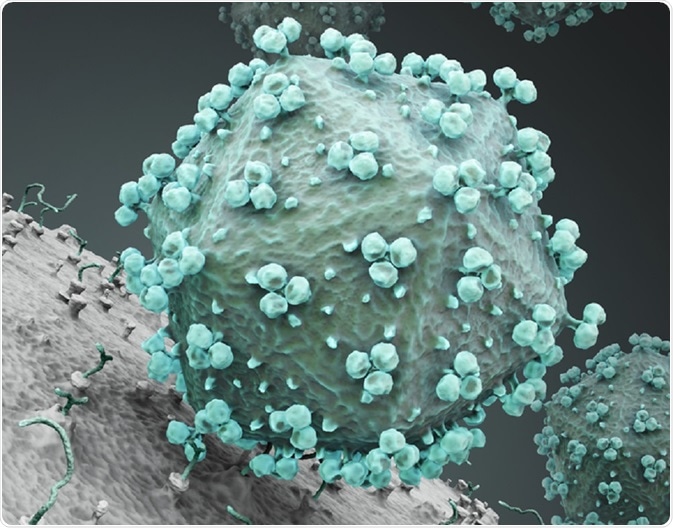CD38, or cyclic ADP ribose hydrolase, is a glycoprotein found on the surface of many immune cells. Binding of CD38 to its target ligand results in T cell co-stimulation, B cell maturation, and induction of cytokine production by several cell types.
HIV infection is characterized by the depletion of CD4+ T cells, leading to a hyperactive immune system. The depletion of CD4+ T cells has long been correlated with the overexpression of the cell surface adhesion receptor protein, CD38.
Skip to:
- CD38 as a predictor of CD4+ T cell depletion
- Mechanism of action
- Products of CD38 catalysis
- CD38 as a pharmacological target
 martynowi | Shutterstock
martynowi | Shutterstock
CD38 as a predictor of CD4+ T cell depletion
CD38 overexpression is a salient aspect of chronic HIV infection and predicts the onset of AIDS with high accuracy. Its expression is consistently predictive compared to other activation markers.
Additionally, it is independent of the frequency of cycling cells. This suggests that CD38 may reflect a mechanism that is independent of the viral-mediated killing of CD4+ T cells. Alternatively, CD38 may directly contribute to T cell loss, which would require an increase in biological activity to cause CD4+ T cell loss or decreased cell renewal. This would occur alongside the HIV-mediated cell lysis and cytopathic effects (changes in host cell structure mediated by viral invasion).
Mechanism of action
The overexpression of CD38 expression during HIV infection increases it's catalytic activity. CD38 is a potent regulator of nicotinamide adenine dinucleotide (NAD), which it uses as a substrate in catalytic reactions. This produces cADPR and ADPR, which mobilize Ca2+ and subsequently increase intracellular Ca2+concentration.
The increased Ca2+concentration, together with depleted NAD, reduce the function and integrity of mitochondria. Survival and proliferation of T cells (T cell viability) from HIV infected patients is consequently reduced.
Products of CD38 catalysis
The increase in NAD turnover results in excessive production of cADPR and ADPR. cADPR activates the ryanodine receptor (RyR) calcium channel, which increases the Ca2+ transport from the endoplasmic reticulum to the cytosol. The effect is enhanced by ADBR which activates transient receptor potential melastatin 2 calcium channel (TRPM2). TRPM2 permits Ca2+ entry from outside the cell to the cytoplasm.
Interestingly, CD38 operates outside of the cell so increases the intracellular concentrations of cADPR and ADPT, which suggests CD38 acts in an autocrine and paracrine manner. The ensuing increase in cytoplasmic Ca2+ further stresses the mitochondria which mediates the release of cytochrome c and programmed cell death.
CD38 as a pharmacological target
CD38 are viable targets for therapeutic outputs. Antagonists of CD38 could be used as a therapeutic tool and act as an adjunct to existing antiretroviral therapy. The effect of this therapeutic intervention is particularly useful in gut‐associated lymphoid tissue where the antiretroviral therapy is limited.
Sources:
- HIV Disease Progression: Overexpression of the Ectoenzyme CD38 as a Contributory Factor? 2018. Bioessays. doi/10.1002/bies.201800128
- ADP-ribosyl Cyclase and CD38 Catalyze the Synthesis of a Calcium-mobilizing Metabolite from NADP+. 1995. The Journal of Biological Chemistry. doi:10.1074/jbc.270.51.30327.
- Crystal Structure of Human CD38 Extracellular Domain. Cell Structure. 2005. 13;9. doi.org/10.1016/j.str.2005.05.012
- Metabolism in T cell activation and differentiation. 2010. Current Opinion in Immunology. 22;3. doi.org/10.1016/j.coi.2010.01.018.
Further Reading